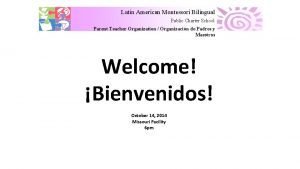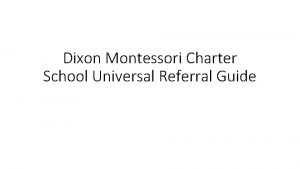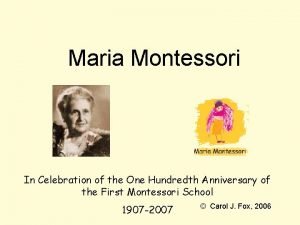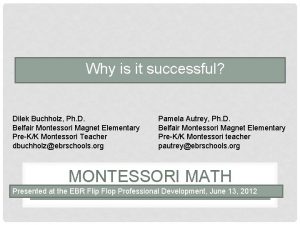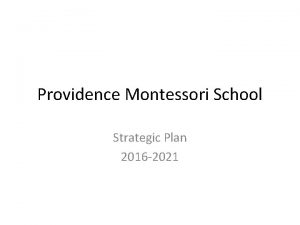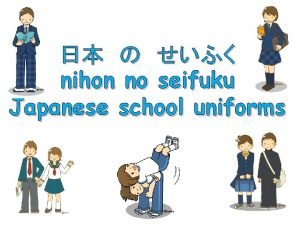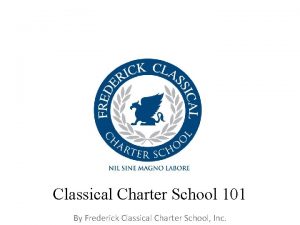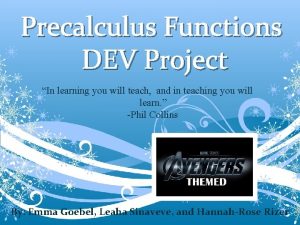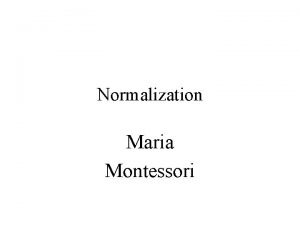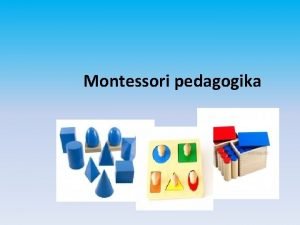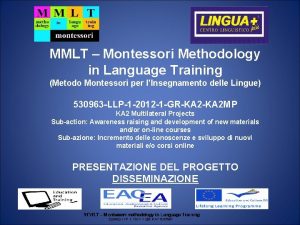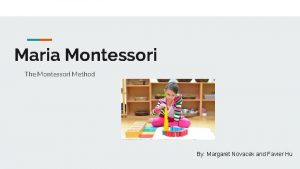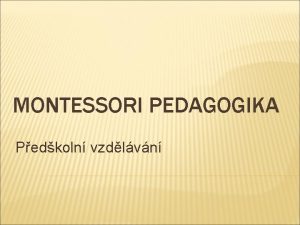MONTESSORI OF WINTER GARDEN CHARTER SCHOOL Elementary School





















- Slides: 21

MONTESSORI OF WINTER GARDEN CHARTER SCHOOL Elementary School Observation by Victoria De. Roy

ARTIFACTS

CLASSROOM RULES – SIGNED BY STUDENTS

SUBJECT | PREDICATE WORKSHEET

PUNCTUATION WORKSHEET

READING HOMEWORK HANDOUT

READING HOMEWORK HANDOUT PART II

CALENDAR

LESSON PLAN

Understanding Simple and Complete Predicates Grade Level Elementary School Subject Language Length of Time 45 minutes Description This lesson covers simple and complete predicates. I have explained the difference and have given examples and exercises for you to use with your students. Goals Students will learn to: Understand simple predicates Understand complete predicates Identify simple and complete predicates in sentences Write sentences correctly using simple and complete predicates Materials Needed You need study sheets and worksheets on simple and complete predicates so that students will understand the difference. I have included some information here for you to use. Predicates Once you have located the subject, the predicates are easy to find. A predicate shows action. The subject is the one who is doing the action. There are different kinds of predicates just like there were for subjects. Simple Predicate The simple predicate, which can be from one to four words long, is the verb in the complete predicate. Here are some examples: 1. The squirrel ran across the yard and over the fence.

2. The girl jogged for one mile to the park and one mile back home. The Complete Predicate The complete predicate is easy to locate once you know what the complete subject is. It's everything in the sentence that the complete subject isn't. Here's an example: The girl with the short brown hair came to my house. Came to my house is the complete predicate. Exercises Look at the following sentences and pick out the complete predicate. 1. The girl ran around the yard. 2. The basketball player scored thirty points in the game. 3. The television show was really scary for the children. 4. He decided to come to my party. 5. Tom and Mary went to the movies. Compound Predicate The compound predicate is two or more verbs joined by a conjunction such as and, or but. Here is an example. The goat ran around the yard and broke through the gate.

Exercises 1. The woman ran out of the house and ran away. 2. Sadey sat on the sofa and then started barking at the people outside. 3. The blue bird flew on the fence and then flew away. 4. The suspect dashed down the street and then hid in an abandoned building. 5. The police turned on their lights and chased the speeding car. Procedure First, you will need to go over subjects to make sure your students understand subjects. Then, you need to explain the difference between simple and complete predicates. You can use the exercises in this lesson on the board as examples to teach the lesson. After that, you can pass out worksheets on simple and complete predicates for students to do. Grading 100 to 90 = A 89 to 80 = B 79 to 70 = C 69 to 60 = D Below 60 = F You can grade by recording the total number correct out of the total number possible on each worksheet.

PICTURES

A READING COMPREHENSION ACTIVITY. STUDENTS READ TOGETHER THEN ASK EACH OTHER QUESTIONS ABOUT DETAILS OF WHAT THEY JUST READ.

MR. EDWIN TEACHING A LESSON ON WORD PROBLEMS

THE CLASSROOM LIBRARY. THE STUDENTS DONATE THE BOOKS FOR THE ENTIRE CLASS TO READ.

SARA DOING A MULTIPLICATION ACTIVITY.

MR. EDWIN READING A STORY TO THE KIDS AFTER RECESS.

PROJECTS LINE THE PARAMETER OF THE CLASSROOM. STUDENTS CHOOSE WHICH ACTIVITIES THEY WOULD LIKE TO DO.

INTERVIEW 1. Do you think that the school culture is different at the elementary level versus the middle or high school level? If so, how? Yes, I think it is because the of the difference in the age and the stage of development. For example, middle school students are reaching puberty and their bodies are changing. They are often insecure and trying to impress their peers. You do not really see that with elementary kids. Yes, they want to be liked but they aren’t really separated into the “cool” kids versus everyone else. 2. What challenges do you face as an elementary school teacher? There is always the problem of being able to meet all of the needs for every single student. Also, in the elementary setting, learning disabilities are being identified. As a teacher, parents turn to you with their concerns and it’s up to you to recognize a problem. Parents can also create challenging situations. During this age they tend to be more involved with their child’s education and some parents can over step the boundaries and start trying to dictate what happens in your classroom. 3. What forms of communication do you use with your parents? At Montessori school we use direct contact with parents. We have multiple meetings with parents throughout the year where we sit down and discuss the issues with the students, the progress with their student, and ways to improve. We also send home news letters and call parents in certain situations 4. What effective teaching strategies are used at the elementary level? I stay at the students level during learning time. I sit on the floor with them, I will sit down next to them. I want to talk to them and not down to them to ensure a trusting and safe environment for the students. For lessons, we take the students into small groups. A certain grade level in my classroom will come to me while the rest work on whatever goals they must complete for that day. These smaller groups allow teachers to connect with the students on an individual basis and check to make sure that the students understand the lesson. 5. What forms of incentives do you utilize with your students in the classroom to enhance extrinsic motivation? The Montessori Method does not utilize incentives like other styles of teaching might. The Montessori Method relies on the curiosity of the students. Although, we do use a weekly goal which has the daily goals laid out for each child and

VERIFICATION FORM
 Latin american montessori bilingual public charter school
Latin american montessori bilingual public charter school Dixon montessori charter school
Dixon montessori charter school Maria montessori birth and death
Maria montessori birth and death Difference between voyage charter and time charter
Difference between voyage charter and time charter Winter kommt winter kommt flocken fallen nieder
Winter kommt winter kommt flocken fallen nieder Heute mittwoch guten morgen mittwoch winter
Heute mittwoch guten morgen mittwoch winter Meine lieblingsjahreszeit ist der winter
Meine lieblingsjahreszeit ist der winter Maria montessori school rockford il
Maria montessori school rockford il Christina manara
Christina manara Belfair montessori magnet school
Belfair montessori magnet school Providence montessori school
Providence montessori school Blessed star montessori christian school
Blessed star montessori christian school School uniform in japan
School uniform in japan Charter school marketing
Charter school marketing Frederick classical charter school
Frederick classical charter school Cape coral charter school authority
Cape coral charter school authority 300x14000
300x14000 Paul revere middle school
Paul revere middle school Imagine school hemet
Imagine school hemet Brass city charter school
Brass city charter school Chatsworth charter high school
Chatsworth charter high school National charter school resource center
National charter school resource center
